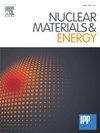Validation of SOLPS-ITER and EDGE2D-EIRENE simulations for H, D, and T JET ITER-like wall low-confinement mode plasmas
IF 2.3
2区 物理与天体物理
Q1 NUCLEAR SCIENCE & TECHNOLOGY
引用次数: 0
Abstract
Both experiments and simulations with SOLPS-ITER and EDGE2D-EIRENE show that the onset of detachment for the low-field side (LFS) divertor – defined here as the line-averaged upstream density () at which the plasma flux to the LFS target () starts to decrease with increasing – is independent of the isotope mass. However, there are three major simulation-experiment discrepancies: (i) the absolute values of and the electron density () in the LFS divertor at the onset of detachment are significantly lower in simulations, i.e., approximately a factor of 2 for and a factor of 3-4 for ; (ii) the degree of detachment – defined here as the difference between at the onset of detachment and at an value close to the density limit – is smaller in simulations compared to experiments; and (iii) the experimentally observed larger degree of detachment for D and T plasmas compared to H plasmas cannot be clearly distinguished from the simulation results. There are strong indications that discrepancy (i) is to a large extent caused by neglecting Lyman-opacity effects in our simulations. The simulations predict a similar net volumetric recombination source for all isotopes due to the fact that molecule-activated recombination (MAR) compensates for the reduced electron–ion recombination (EIR) for H, whereas MAR is negligible for D and T. This similar net volumetric recombination source for all isotopes leads to an isotope-independent degree of detachment in simulations. An analysis of the Balmer- and Balmer- emission confirms the underestimate of MAR in simulations (especially for D and T) for the JET metallic wall, which was previously observed for devices with a carbon wall. The underestimate of MAR is an important cause for discrepancy (ii) and the fact that there is a stronger underestimate of MAR for D and T than for H explains discrepancy (iii). Extending the plasma grid to the vessel wall increases and at the onset of detachment by 25%, and the EIR source increases by 80% in detached conditions. Hence, while the extended grid results are closer to the experimental observations, the previously described qualitative discrepancies still persist.
求助全文
约1分钟内获得全文
求助全文
来源期刊

Nuclear Materials and Energy
Materials Science-Materials Science (miscellaneous)
CiteScore
3.70
自引率
15.40%
发文量
175
审稿时长
20 weeks
期刊介绍:
The open-access journal Nuclear Materials and Energy is devoted to the growing field of research for material application in the production of nuclear energy. Nuclear Materials and Energy publishes original research articles of up to 6 pages in length.
 求助内容:
求助内容: 应助结果提醒方式:
应助结果提醒方式:


